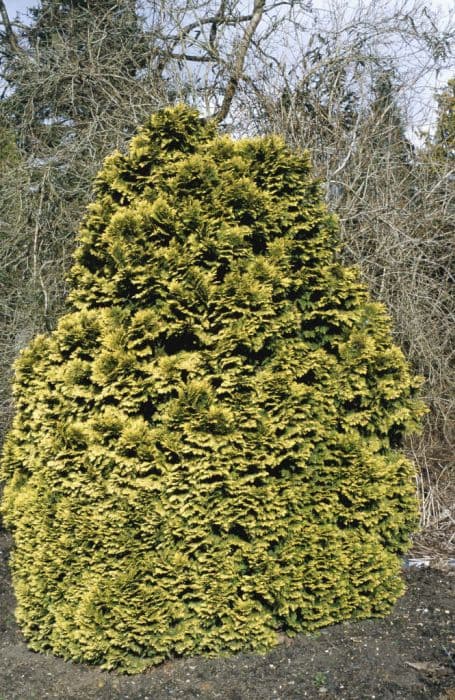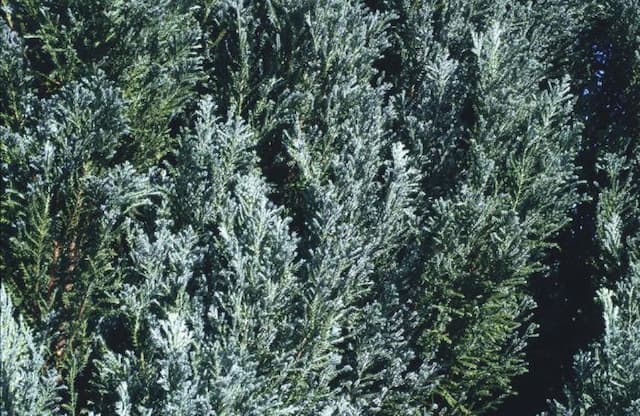Italian Cypress Cupressus sempervirens 'Swane's Gold'

ABOUT
The Cupressus sempervirens 'Swane's Gold', commonly known as the Italian Cypress 'Swane's Gold', is a striking evergreen conifer characterized by its brilliant golden-yellow foliage. The foliage consists of dense sprays of scale-like leaves, which are soft to the touch and emit a pleasing, characteristic fragrance when crushed. The golden color provides a bright contrast against darker, green plants in a landscape. This Italian Cypress variety maintains a narrow and columnar growth habit, lending itself to architectural uses in garden design such as creating stately avenues or framing doorways and gateways. Its slender form is comprised of erect branches that grow closely together, creating a compact appearance. The conical outline is accentuated by the upward growth of its branches, which are clothed with the luminous golden leaves. The visual appeal of 'Swane's Gold' is further enhanced when the branches and leaves gently sway with the breeze, creating a dynamic and shimmering effect in the sunlight. With the play of light and wind, this variety acts as a beacon in the landscape, drawing attention with its vibrant hue. Its color and form combine to make it an excellent choice for adding vertical interest and color to gardens without taking up significant horizontal space.
About this plant
 Names
NamesFamily
Cupressaceae
Synonyms
Golden Italian Cypress, Swane's Golden Cypress, Swane's Gold Cypress
Common names
Cupressus sempervirens 'Swane's Gold'.
 Toxicity
ToxicityTo humans
The Italian Cypress is not typically known to be toxic to humans. However, as with any plant material, individual reactions can occur, and it is generally not advisable to ingest plant parts that are not specifically meant for consumption.
To pets
The Italian Cypress is also not commonly known to be toxic to pets. Again, ingestion of plant materials not intended for consumption can potentially cause gastrointestinal upset in some animals, but there are no widely recognized toxic effects specific to this plant variety in pets. It is always a good practice to keep an eye on pets to ensure they do not consume plants that are not part of their normal diet.
 Characteristics
CharacteristicsLife cycle
Perennials
Foliage type
Evergreen
Color of leaves
Gold
Height
15 feet (4.6 meters)
Spread
3 feet (0.9 meters)
Plant type
Tree
Hardiness zones
7
Native area
Mediterranean
Benefits
 General Benefits
General Benefits- Aesthetic Appeal: Swane's Gold offers year-round golden foliage that provides striking visual interest in landscapes.
- Drought Tolerance: As a Mediterranean species, it is quite tolerant of dry conditions once established, requiring minimal irrigation.
- Low Maintenance: It requires little pruning or care to maintain its narrow, columnar shape, making it ideal for busy or novice gardeners.
- Privacy Screen: Its dense growth habit makes it a good choice for creating privacy screens or hedges.
- Windbreak: The tree can act as a windbreak when planted in rows, protecting gardens or homes from strong winds.
- Vertical Accent: The columnar form provides a strong vertical element, useful for breaking up horizontal lines in garden design.
- Erosion Control: Its root system can help stabilize slopes and prevent soil erosion.
- Habitat Support: While not a primary wildlife plant, it can offer some shelter and nesting sites for birds.
- Adaptability: Swane's Gold adapts well to a wide range of soil types as long as they are well-drained.
- Urban Tolerant: It can handle urban conditions like pollution and limited soil spaces, suitable for city planting.
 Medical Properties
Medical PropertiesThis plant is not used for medical purposes.
 Air-purifying Qualities
Air-purifying QualitiesThis plant is not specifically known for air purifying qualities.
 Other Uses
Other Uses- Crafting and Woodworking: The aromatic wood of the Italian Cypress can be used in small woodworking projects, such as crafting ornaments, boxes, or even specialty pens.
- Cultural Symbolism: This plant is often planted in gardens to represent mourning and is also associated with cemeteries, making it a symbol of remembrance in various cultures.
- Hedge and Topiary Forms: Because it can be pruned and shaped easily, the Italian Cypress is used for creating living fences and artistic topiary forms in formal gardens.
- Windbreaks: In large open spaces, the Italian Cypress is planted in rows to serve as windbreaks, protecting smaller plants and reducing soil erosion.
- Noise Barrier: The dense foliage of Italian Cypress can help mitigate noise when planted along highways or noisy areas.
- Erosion Control: Its robust root system makes this evergreen a good choice for stabilizing slopes and preventing soil erosion in hilly terrains.
- Privacy Screening: Due to its tall and narrow growth habit, the Italian Cypress is often used to create privacy screens in residential landscapes.
- Landscape Accent: The striking golden-yellow foliage of 'Swane's Gold' offers a vivid contrast in gardens, often used as a focal point in landscape design.
- Fragrance Source: The foliage releases a distinct clean and woody scent when brushed against or after rainfall, adding an olfactory dimension to the garden.
- Film and Theatre: Italian Cypress is sometimes incorporated into stage designs and movie sets to create a Mediterranean atmosphere or to replicate historical garden settings.
Interesting Facts
 Feng Shui
Feng ShuiThe Italian Cypress is not used in Feng Shui practice.
 Zodiac Sign Compitability
Zodiac Sign CompitabilityThe Italian Cypress is not used in astrology practice.
 Plant Symbolism
Plant Symbolism- Immortality and Longevity: As a variety of cypress tree, the Swane's Gold is often linked with immortality due to its evergreen nature and the long lifespan of cypress trees.
- Mourning: Cypress trees, including Swane's Gold, are commonly found in graveyards and have historically symbolized mourning and the afterlife, representing eternal life or the mourning of the deceased.
- Resilience: The hardy nature of Swane's Gold illustrates resilience and the ability to withstand tough conditions, making it a symbol of strength.
 Water
WaterThe Italian Cypress 'Swane's Gold' should be watered regularly after planting until it's well-established, usually for the first few months, aiming for moist but not waterlogged soil. Once established, this drought-tolerant tree requires less frequent watering, maybe once every two to three weeks. In the absence of rainfall, provide about 1 to 2 gallons per week during the active growing season, and reduce watering in the winter months. Deep, infrequent waterings are preferable to encourage deep root growth, ensuring the water reaches down into the soil around the root zone.
 Light
LightItalian Cypress 'Swane's Gold' thrives in a location with full sun exposure to maintain its vivid foliage color. Ideally, plant this tree in a spot where it can enjoy unfiltered sunlight for at least six hours a day. The bright, direct sun ensures the best color and form, as well as optimal growth and plant health.
 Temperature
TemperatureThe Italian Cypress 'Swane's Gold' is hardy and can tolerate a wide range of temperatures, but it grows best in areas where the average temperatures are between 65 and 80 degrees Fahrenheit. It can withstand temperatures as low as 10 degrees Fahrenheit and as high as 90 degrees Fahrenheit, but for optimal growth, maintaining a temperature within the ideal range is advisable.
 Pruning
PruningPruning the Italian Cypress 'Swane's Gold' is generally done to shape the tree, maintain its size, or remove any damaged or diseased branches. It's best to prune in the late winter or early spring before new growth starts. Annual or biennial pruning is often enough to keep the tree looking its best. When pruning, always use clean, sharp tools to make precise cuts that will heal swiftly.
 Cleaning
CleaningAs needed
 Soil
SoilThe Italian Cypress 'Swane's Gold' thrives in well-drained soil with a mix of soil, sand, and peat to improve drainage. The ideal soil pH is slightly acidic to neutral, ranging from 6.0 to 7.5.
 Repotting
RepottingItalian Cypress 'Swane's Gold' is typically grown in the ground and does not require frequent repotting. Repot container plants when rootbound, generally every 2 to 3 years.
 Humidity & Misting
Humidity & MistingItalian Cypress 'Swane's Gold' prefers moderate humidity but is adaptable and can tolerate lower humidity levels commonly found in outdoor environments.
 Suitable locations
Suitable locationsIndoor
Provide bright light and occasional watering.
Outdoor
Plant in full sun, well-draining soil, water sparingly.
Hardiness zone
7-10 USDA
 Life cycle
Life cycleItalian Cypress 'Swane's Gold' begins its life as a seed, which once in suitable conditions, germinates and develops into a young seedling. Seedlings gradually mature into saplings, showcasing the distinctive golden-yellow foliage that contrasts with the species' more typical green. As the saplings grow, they form narrow, columnar trees that can reach heights of 15 to 25 feet. Throughout its life, the tree will produce small, rounded cones which mature over time and release seeds, thus enabling the next generation of Italian Cypress 'Swane's Gold'. This cultivar has a relatively slow to moderate growth rate and can live for many decades, often requiring minimal maintenance once established. It completes its life cycle when it eventually succumbs to old age, disease, or environmental factors, at which point it may decompose or be removed, and its seeds continue the cycle anew.
 Propogation
PropogationPropogation time
Late winter
The Italian Cypress, specifically the 'Swane's Gold' variety, is often propagated through semi-hardwood cuttings. This method is usually carried out in late summer. To propagate, select a healthy, disease-free branch and cut a piece about 6 to 8 inches (15 to 20 centimeters) long. The cut should be made just below a node, where there is a concentration of hormones to encourage root growth. Remove the lower one-third to one-half of the leaves to reduce moisture loss and dip the cut end in rooting hormone powder to enhance root development. The cutting should then be planted in a well-draining soil mix with the bottom half of the stem buried. Providing a consistent moisture level and maintaining a high humidity environment, for example by covering the cutting with a plastic bag, is essential for successful rooting. It may take several months for the cutting to establish and begin new growth.









